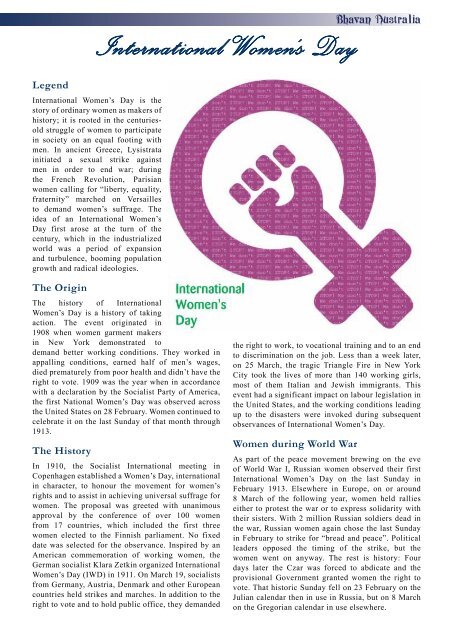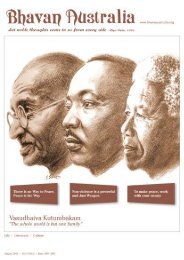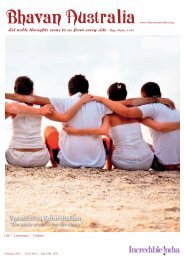'The whole world is but one family' - Bharatiya Vidya Bhavan Australia
'The whole world is but one family' - Bharatiya Vidya Bhavan Australia
'The whole world is but one family' - Bharatiya Vidya Bhavan Australia
Create successful ePaper yourself
Turn your PDF publications into a flip-book with our unique Google optimized e-Paper software.
Legend<br />
International Women’s Day<br />
International Women’s Day <strong>is</strong> the<br />
story of ordinary women as makers of<br />
h<strong>is</strong>tory; it <strong>is</strong> rooted in the centuriesold<br />
struggle of women to participate<br />
in society on an equal footing with<br />
men. In ancient Greece, Lys<strong>is</strong>trata<br />
initiated a sexual strike against<br />
men in order to end war; during<br />
the French Revolution, Par<strong>is</strong>ian<br />
women calling for “liberty, equality,<br />
fraternity” marched on Versailles<br />
to demand women’s suffrage. The<br />
idea of an International Women’s<br />
Day first arose at the turn of the<br />
century, which in the industrialized<br />
<strong>world</strong> was a period of expansion<br />
and turbulence, booming population<br />
growth and radical ideologies.<br />
The Origin<br />
The h<strong>is</strong>tory of International<br />
Women’s Day <strong>is</strong> a h<strong>is</strong>tory of taking<br />
action. The event originated in<br />
1908 when women garment makers<br />
in New York demonstrated to<br />
demand better working conditions. They worked in<br />
appalling conditions, earned half of men’s wages,<br />
died prematurely from poor health and didn’t have the<br />
right to vote. 1909 was the year when in accordance<br />
with a declaration by the Social<strong>is</strong>t Party of America,<br />
the first National Women’s Day was observed across<br />
the United States on 28 February. Women continued to<br />
celebrate it on the last Sunday of that month through<br />
1913.<br />
The H<strong>is</strong>tory<br />
In 1910, the Social<strong>is</strong>t International meeting in<br />
Copenhagen establ<strong>is</strong>hed a Women’s Day, international<br />
in character, to honour the movement for women’s<br />
rights and to ass<strong>is</strong>t in achieving universal suffrage for<br />
women. The proposal was greeted with unanimous<br />
approval by the conference of over 100 women<br />
from 17 countries, which included the first three<br />
women elected to the Finn<strong>is</strong>h parliament. No fixed<br />
date was selected for the observance. Inspired by an<br />
American commemoration of working women, the<br />
German social<strong>is</strong>t Klara Zetkin organized International<br />
Women’s Day (IWD) in 1911. On March 19, social<strong>is</strong>ts<br />
from Germany, Austria, Denmark and other European<br />
countries held strikes and marches. In addition to the<br />
right to vote and to hold public office, they demanded<br />
the right to work, to vocational training and to an end<br />
to d<strong>is</strong>crimination on the job. Less than a week later,<br />
on 25 March, the tragic Triangle Fire in New York<br />
City took the lives of more than 140 working girls,<br />
most of them Italian and Jew<strong>is</strong>h immigrants. Th<strong>is</strong><br />
event had a significant impact on labour leg<strong>is</strong>lation in<br />
the United States, and the working conditions leading<br />
up to the d<strong>is</strong>asters were invoked during subsequent<br />
observances of International Women’s Day.<br />
Women during World War<br />
As part of the peace movement brewing on the eve<br />
of World War I, Russian women observed their first<br />
International Women’s Day on the last Sunday in<br />
February 1913. Elsewhere in Europe, on or around<br />
8 March of the following year, women held rallies<br />
either to protest the war or to express solidarity with<br />
their s<strong>is</strong>ters. With 2 million Russian soldiers dead in<br />
the war, Russian women again chose the last Sunday<br />
in February to strike for “bread and peace”. Political<br />
leaders opposed the timing of the strike, <strong>but</strong> the<br />
women went on anyway. The rest <strong>is</strong> h<strong>is</strong>tory: Four<br />
days later the Czar was forced to abdicate and the<br />
prov<strong>is</strong>ional Government granted women the right to<br />
vote. That h<strong>is</strong>toric Sunday fell on 23 February on the<br />
Julian calendar then in use in Russia, <strong>but</strong> on 8 March<br />
on the Gregorian calendar in use elsewhere.









